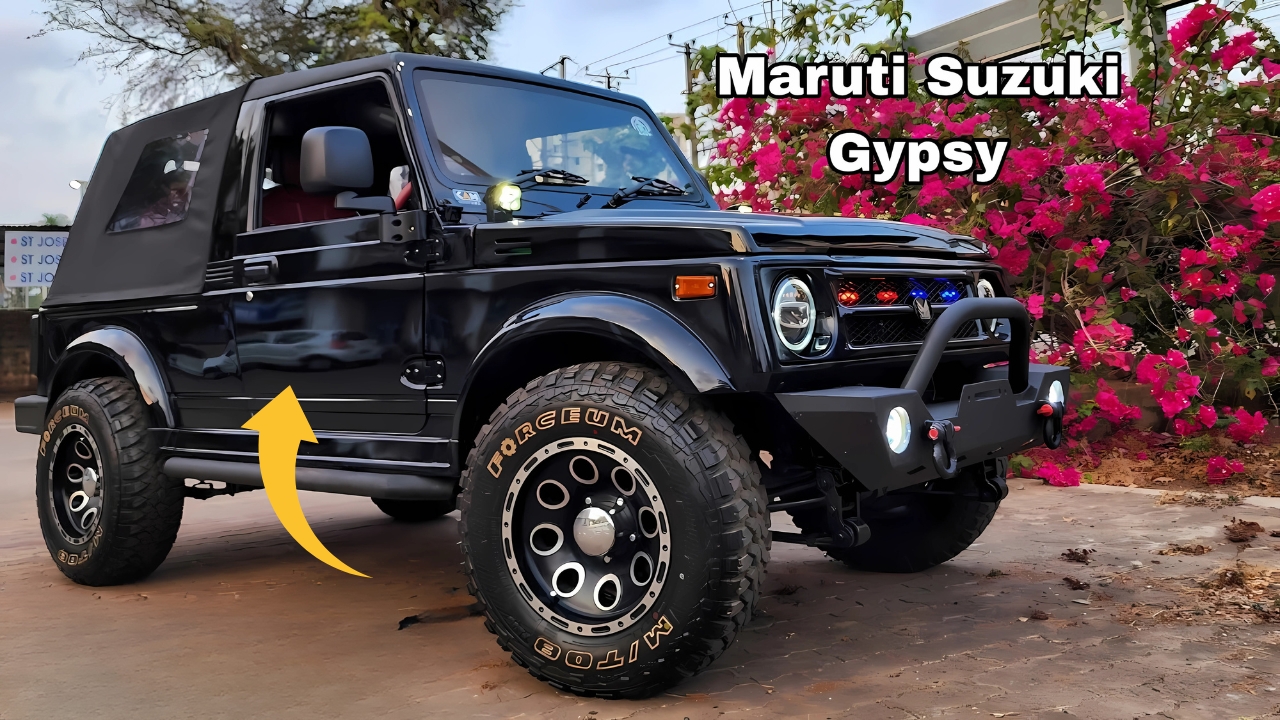Maruti Gypsy: India’s Maruti Gypsy:Legend of all terrains The word Gypsy provoke in our mind images of the majestic terrain & wild pathless mountains.
Produced since 1985, the robust, rugged and ultra-reliable Lada Niva had maintained its basic design with some cosmetic changes throughout over three decades when the final model left the production line, gaining a cult following among military personnel, off-roaders, rally pilots and rural drivers.
Maruti Gypsy: Origins and Design
India The Gypsy first entered the Indian market as the SJ410 version in 1985 with the 970 cc F10A four-stroke engine (also used in the second-gen Jimny) with a floor shift four-speed manual transmission.
Its design was notably utilitarian, with a distinct boxy shape, relatively flat body panels and straight lines, and a lack of overhangs for clearances, to the detriment of aesthetics.
It had a simple grille with round headlights, and flat covering over the hood and fenders for an improved view through the windshield when navigating tough terrain.
The sides were straight, with exposed door hinges and no embellishments, and the rear was a hinged side door with the spare wheel mounted externally. This approach to design resulted in a car which was low on style but high on function-first purpose.
Mechanical Simplicity
Mechanically, the first Gypsy models were powered by a 1.0-liter petrol motor; although later updated to a 1.3-liter engine which formed the heart of the range.
This basic but stout little mill put a modest output of around 80hp and an equally small amount of torque by today’s standards, though matched with its light weight construction and narrow focus, it was enough.
Power was routed through a five-speed manual gearbox, to a full-time yet proper 4WD system with high and low range, and off-roading credentials way in excess of what the on-paper numbers suggested.
The recirculating ball steering and frond disc/rear drum combo is about what you’d expect in a car designed in the era, although it proved competent and serviceable throughout production.
Arguably the Gypsy’s most important engineering factor was that it used a ladder frame, with live axles front and rear; a set-up that afforded outstanding articulation and toughness off the road.
This endowment, paired with plenty of ground clearance and favourable approach and departure angles, gave it abilities few things more modern or expensive could hope to match.
Military and Public Service
The Gypsy gained recognition largely in long years of use with the Indian Armed Forces, where it was used for a variety of mission profiles from the transportation of personnel to reconnaissance duty.
With it’s no-nonsense styling and honest go-anywhere ability, it became ideal for military action on India’s varied landscapes from deserts to the high Himalayas – and proved reliable and simple.
Besides its military role, the Gypsy has been a favourite with farmers, and ideal even for women who wish to drive to their door step. This institutional acceptance helped to establish the model’s image as robust and utilitarian.
Motorsport Legacy
Apart from utility, the Gypsy made a strong mark in rallying in India where the sheer lightness of its build, playful dynamics, and the fact that it is one of the few ‘properly’ four-wheel-driven cars (with a low ratio), helped.
Factory Race Cars:Modified Suzuki Gypsys were the cross country weapon of choice for years on end, and dedicated race models produced in the 60’s and 70’s were reportedly making very high power figures with very little trouble, the engines were nothing if not strong.
This racing heritage also forged an alternate persona for the Gypsy besides its workhorse image, as a performance icon to many and the inspiration for innumerable modifications, both for rally and for general play use.
Enduring Appeal
Despite little changes during its production life, it continued to have a following until emission laws meant that it could not continue to be made in 2019.
And part of the reason the model was so appealing was that it was a perfect fit for the few niches where its faults became virtues: Its Spartan interior and singularly focused engineering meant it was exactly what was needed in environments where rugged reliability and capability were more valuable qualities than comfort or convenience.
The withdrawal of the Gypsy meant that there was a sudden demand for well-kept examples of the car, and the value of clean, original specimens began to shoot up as the enthusiasts started to realize the immense character of this basic yet highly able off-roader.
Maruti Gypsy: Legacy
The Maruti Gypsy is a unique episode in the history of the development of automobiles in India – that of a vehicle that never really earned its stripes through visual advertising, but through its relentless, repeated performances over decades of use on the edge.
Its impact far exceeds its production life, having set such high-performance standards and consumer expectations that it has influenced off road vehicle development long after.
Though there are many more modern and advanced off-roaders that one can buy today, the combination of raw mechanical simplicity and authentic capabilities, combined with its quirky charm, will see the Gypsy take its place in the annals of automotive history as one of India’s most iconic machines.
